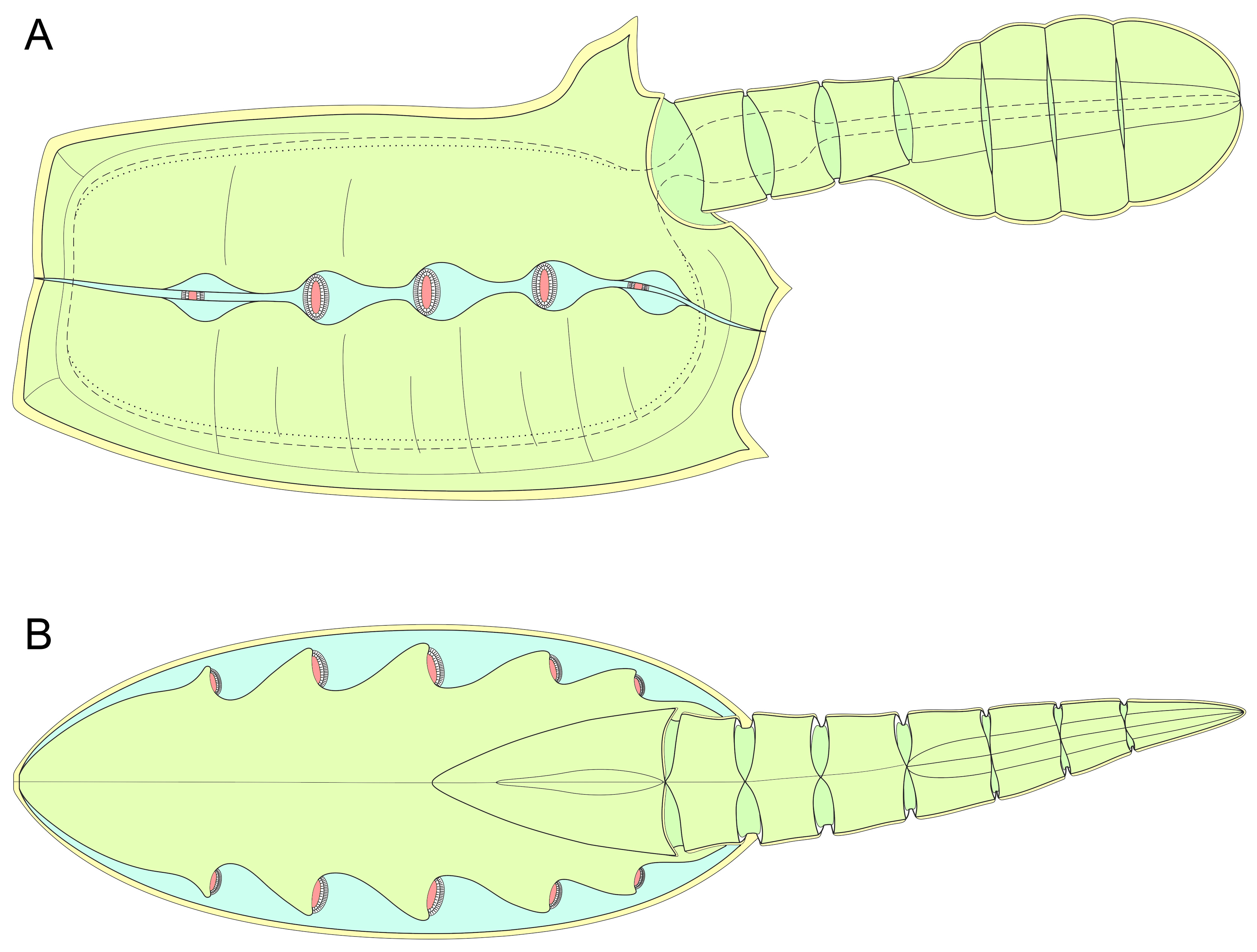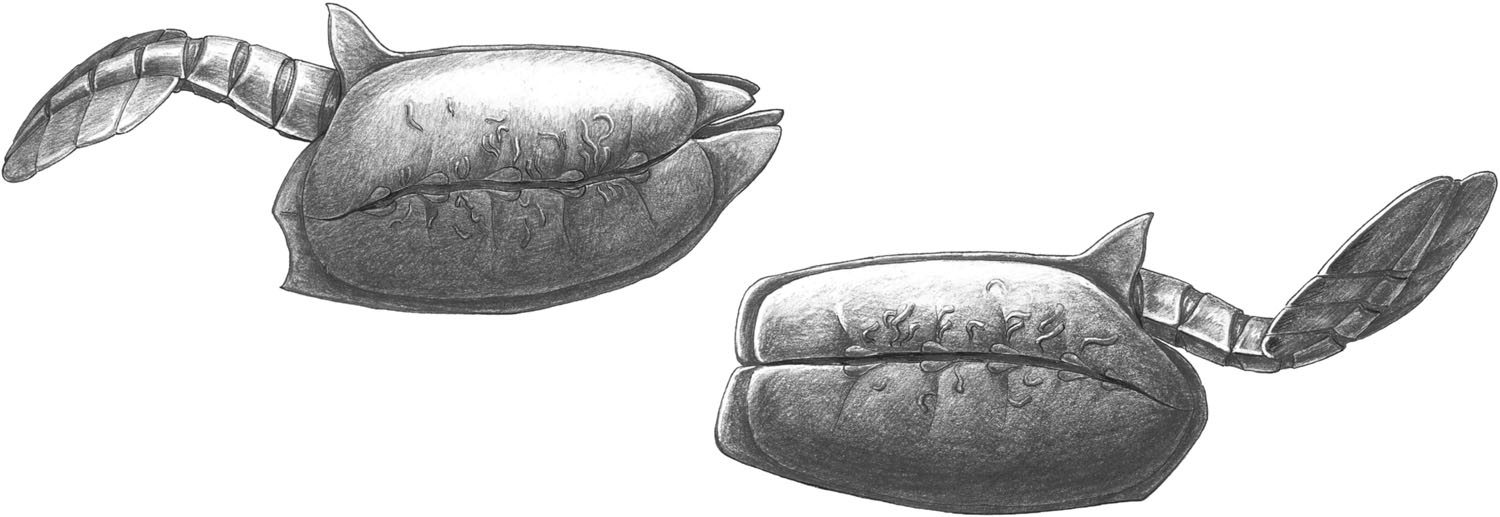|
Shenzianyuloma
''Shenzianyuloma'' is an extinct genus of vetulicolian represented by a single species, ''Shenzianyuloma yunnanense'', from the Maotianshan Shale during Cambrian Stage 3, Stage 3 (518 million years ago) of the Cambrian period. It is notable for having a compact body shape akin to that of an angelfish. Its exact phylogenetic position is unclear, and it was not included in a 2024 phylogenetic analysis and 2025 review of vetulicolians. Etymology The name of the genus is derived from the Chinese language, Chinese ''shénxiān yú'' (神仙鱼), meaning "Pterophyllum, angelfish", and an anagram of ''Mola (fish), Mola''. Provenance The ''Shenzianyuloma'' holotype was acquired from a "crystal and fossil vendor" in Lianyungang, Jiangsu, China, and assigned to the Maotianshan shale based on the presence of the brachiopod ''Diadonga pista'' on the same slab, as well as the rock's matrix characteristics. Taxonomy As of late 2024, ''Shenzianyuloma'' has only been discussed in two papers, ... [...More Info...] [...Related Items...] OR: [Wikipedia] [Google] [Baidu] |
Vetulicolian
Vetulicolia is a group of bilaterian marine animals encompassing several extinct species from the Cambrian, and possibly Ediacaran, periods. As of 2023, the majority of workers favor placing Vetulicolians in the stem group of the Chordata, but some continue to favor a more crownward placement as a sister group to the Tunicata. It was initially erected as a monophyletic clade with the rank of phylum in 2001, with subsequent work supporting its monophyly. However, more recent research suggests that vetulicolians may be paraphyletic and form a basal evolutionary grade of stem chordates. Etymology The taxon name, Vetulicolia, is derived from the type genus, ''Vetulicola'', which is a compound Latin word composed of ''vetuli'' "old" and ''cola'' "inhabitant". It was named after ''Vetulicola cuneata'', the first species of the group described in 1987. Description The vetulicolian body plan comprises two parts: a voluminous rostral (anterior) forebody, tipped with an anteriorly ... [...More Info...] [...Related Items...] OR: [Wikipedia] [Google] [Baidu] |
Mark McMenamin
Mark A. S. McMenamin (born c. 1957) is an American paleontologist and professor of geology at Mount Holyoke College. He has contributed to the study of the Cambrian explosion and the Ediacaran biota. He is the author of several books, most recently ''Deep Time Analysis'' (2018) and ''Dynamic Paleontology'' (2016). His earlier works include ''The Garden of Ediacara: Discovering the Earliest Complex Life'' (1998), one of the only popular accounts of research on the Ediacaran biota, and ''Science 101: Geology'' (2007). He is credited with co-naming several geological formations in Mexico, describing several new fossil genera and species, and naming the Precambrian supercontinent Rodinia and the superocean Mirovia. The Cambrian archeocyathid species ''Markocyathus clementensis'' was named in his honor in 1989. Early life and career McMenamin was born in Oregon, earned his B.S. at Stanford University in 1979 and his PhD at the University of California, Santa Barbara in 1984. ... [...More Info...] [...Related Items...] OR: [Wikipedia] [Google] [Baidu] |
Chordates
A chordate ( ) is a bilaterian animal belonging to the phylum Chordata ( ). All chordates possess, at some point during their larval or adult stages, five distinctive physical characteristics ( synapomorphies) that distinguish them from other taxa. These five synapomorphies are a notochord, a hollow dorsal nerve cord, an endostyle or thyroid, pharyngeal slits, and a post- anal tail. In addition to the morphological characteristics used to define chordates, analysis of genome sequences has identified two conserved signature indels (CSIs) in their proteins: cyclophilin-like protein and inner mitochondrial membrane protease ATP23, which are exclusively shared by all vertebrates, tunicates and cephalochordates. These CSIs provide molecular means to reliably distinguish chordates from all other animals. Chordates are divided into three subphyla: Vertebrata (fish, amphibians, reptiles, birds and mammals), whose notochords are replaced by a cartilaginous/ bony axial ... [...More Info...] [...Related Items...] OR: [Wikipedia] [Google] [Baidu] |
Stem Group
In phylogenetics, the crown group or crown assemblage is a collection of species composed of the living representatives of the collection, the most recent common ancestor of the collection, and all descendants of the most recent common ancestor. It is thus a way of defining a clade, a group consisting of a species and all its extant or extinct descendants. For example, Neornithes (birds) can be defined as a crown group, which includes the most recent common ancestor of all modern birds, and all of its extant or extinct descendants. The concept was developed by Willi Hennig, the formulator of phylogenetic systematics, as a way of classifying living organisms relative to their extinct relatives in his "Die Stammesgeschichte der Insekten", and the "crown" and "stem" group terminology was coined by R. P. S. Jefferies in 1979. Though formulated in the 1970s, the term was not commonly used until its reintroduction in 2000 by Graham Budd and Sören Jensen. Contents of the crown ... [...More Info...] [...Related Items...] OR: [Wikipedia] [Google] [Baidu] |
Vetulicola
''Vetulicola'' is an extinct genus of marine animal discovered from the Cambrian of China. It is the eponymous member of the enigmatic taxon Vetulicolia, which is of uncertain affinities but may belong to the deuterostomes. The name was derived from ''Vetulicola cuneata,'' the first species described by Hou Xian-guang in 1987 from the Lower Cambrian Chiungchussu Formation in Chengjiang, China. Etymology ''Vetulicola'' is a compound Latin word composed of ''vetuli'', meaning "old," or "ancient," and ''cola'', meaning "inhabitant." Description The type species, ''Vetulicola cuneata'', as originally described by Hou Xian-guang in 1987, has a body plan similar to those of arthropods and composed of two distinct parts of approximately equal length. The anterior part is rectangular with a carapace-like structure of four rigid cuticular plates, with a large mouth at the front end. The posterior section is slender, strongly cuticularised and placed dorsally. Paired openings connecti ... [...More Info...] [...Related Items...] OR: [Wikipedia] [Google] [Baidu] |
Nesonektris
''Nesonektris aldridgei'' is an extinct vetulicolian from the Late Botomian-aged Emu Bay Shale Lagerstätte in Kangaroo Island, Australia. So far, it is the fourth described vetulicolian that is not restricted to the Maotianshan Shales (the other three being '' Ooedigera'' of Sirius Passet, '' Banffia'' of the Burgess Shale, and '' Skeemella'' of the Pierson Cove Formation above the Wheeler Shale). Description ''N. aldridgei'' is known from several incomplete fossils which suggest that, in life, it was a fairly large animal (when compared to other vetulicolians). The largest fossil is about 150 millimetres ( 5.9 inches) long, leading researchers to estimate that that individual was about 170 millimetres (6.7 inches) long. The exquisitely preserved fossils show that running the length inside the tail was a notochord, thereby demonstrating the animal's chordate affinities as being related to tunicates. The forebody, and overall form are similar to vetulicolids of Vetulicol ... [...More Info...] [...Related Items...] OR: [Wikipedia] [Google] [Baidu] |
MDPI
MDPI (Multidisciplinary Digital Publishing Institute) is a publisher of open-access scientific journals. It publishes over 390 peer-reviewed, open-access journals. MDPI is among the largest publishers in the world in terms of journal article output, and is the largest publisher of open access articles. It was founded by Shu-Kun Lin as a chemical sample archive. Between 2016 and 2020, the number of peer-reviewed papers published by MDPI grew significantly, with year-over-year growth of over 50% in 2017, 2018 and 2019, attracting attention to their very fast article processing times. In a review of 26 open-access "mega-journals" that published over 3,500 papers in 2022, 11 (42%) of the journals were from MDPI. Besides launching its own journals, MDPI has acquired journals from other publishers, such as ''Tomography'' from Grapho Publications in 2021, and ''Nursing Reports'' and ''Audiology Research'' from PagePress Publications in 2020. As of January 2024, MDPI publishes 433 aca ... [...More Info...] [...Related Items...] OR: [Wikipedia] [Google] [Baidu] |
Maotianshan Shale
The Maotianshan Shales () are a series of Early Cambrian sedimentary deposits in the Chiungchussu Formation or Heilinpu Formation, famous for their '' Konservat Lagerstätten'', deposits known for the exceptional preservation of fossilized organisms or traces. The Maotianshan Shales form one of some forty Cambrian fossil locations worldwide exhibiting exquisite preservation of rarely preserved, non-mineralized soft tissue, comparable to the fossils of the Burgess Shale of British Columbia, Canada. They take their name from Maotianshan Hill () in Chengjiang County, Yunnan Province, China. The most famous assemblage of organisms are referred to as the Chengjiang biota for the multiple scattered fossil sites in Chengjiang. The age of the Chengjiang Lagerstätte is locally termed Qiongzhusian, a stage correlated to the late Atdabanian Stage in Siberian sequences of the middle of the Early Cambrian. The shales date to ≤. Along with the Burgess Shale, the Maotianshan Shales ar ... [...More Info...] [...Related Items...] OR: [Wikipedia] [Google] [Baidu] |
Brachiopod
Brachiopods (), phylum (biology), phylum Brachiopoda, are a phylum of animals that have hard "valves" (shells) on the upper and lower surfaces, unlike the left and right arrangement in bivalve molluscs. Brachiopod valves are hinged at the rear end, while the front can be opened for feeding or closed for protection. Two major categories are traditionally recognized, articulate and inarticulate brachiopods. The word "articulate" is used to describe the tooth-and-groove structures of the valve-hinge which is present in the articulate group, and absent from the inarticulate group. This is the leading diagnostic skeletal feature, by which the two main groups can be readily distinguished as fossils. Articulate brachiopods have toothed hinges and simple, vertically oriented opening and closing muscles. Conversely, inarticulate brachiopods have weak, untoothed hinges and a more complex system of vertical and oblique (diagonal) muscles used to keep the two valves aligned. In many brachio ... [...More Info...] [...Related Items...] OR: [Wikipedia] [Google] [Baidu] |
Mola (fish)
A sunfish, also called a mola, is any fish in the genus ''Mola'' (family Molidae). The fish develop their truncated, bullet-like shape because the back fin, which is present at birth, never grows. Instead, it folds into itself as the creature matures, creating a rounded rudder called a clavus. ''Mola'' in Latin means "millstone" and describes the ocean sunfish's somewhat circular shape. They are a silvery color and have a rough skin texture. The mola is the heaviest of all the bony fish, with large specimens reaching vertically and horizontally, and weighing over . Sharks and rays can be heavier, but they are cartilaginous fish. Mola are found in temperate and tropical oceans around the world. They are frequently seen basking in the sun near the surface and are often mistaken for sharks when their huge dorsal fins emerge above the water. Their teeth are fused into a beak-like structure, and they are unable to fully close their relatively small mouths. Ocean sunfish can be ... [...More Info...] [...Related Items...] OR: [Wikipedia] [Google] [Baidu] |
Pterophyllum
''Pterophyllum'' is a small genus of freshwater fish from the family Cichlidae known to most aquarists as angelfish. All ''Pterophyllum'' species originate in the Amazon Basin, Orinoco Basin and various rivers in the Guiana Shield in tropical South America. The three species of ''Pterophyllum'' are unusually shaped for cichlids, being greatly laterally compressed, with round bodies and elongated triangular dorsal and anal fins. This body shape allows them to hide among roots and plants, often on a vertical surface. Naturally occurring angelfish are frequently striped transversely, colouration which provides additional camouflage. Angelfish are ambush predators and prey on small fish and macroinvertebrates. All ''Pterophyllum'' species form monogamous pairs. Eggs are generally laid on a submerged log or a flattened leaf but can also be laid on filter piping when kept in an aqaurium setting. As is the case for other cichlids, brood care is highly developed. ''Pterophyllum'' sh ... [...More Info...] [...Related Items...] OR: [Wikipedia] [Google] [Baidu] |






